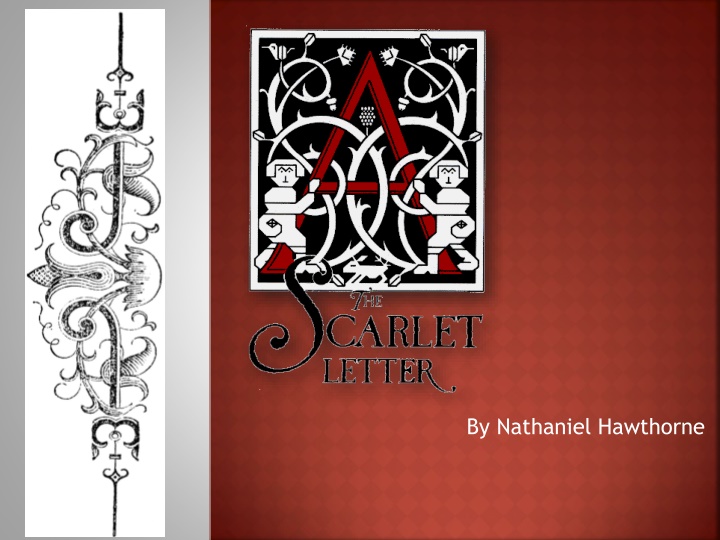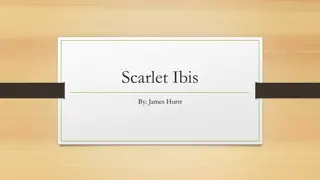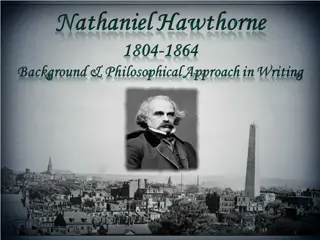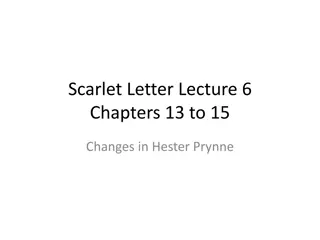Insights into Nathaniel Hawthorne's Novel: The Scarlet Letter
Delve into the background of Nathaniel Hawthorne and his connection to Salem, Massachusetts, as well as the Puritan past that heavily influences his renowned novel, The Scarlet Letter. Discover intriguing facts about colonial Massachusetts laws and how this classic novel came to be, capturing the essence of Hawthorne's literary legacy.
Download Presentation

Please find below an Image/Link to download the presentation.
The content on the website is provided AS IS for your information and personal use only. It may not be sold, licensed, or shared on other websites without obtaining consent from the author.If you encounter any issues during the download, it is possible that the publisher has removed the file from their server.
You are allowed to download the files provided on this website for personal or commercial use, subject to the condition that they are used lawfully. All files are the property of their respective owners.
The content on the website is provided AS IS for your information and personal use only. It may not be sold, licensed, or shared on other websites without obtaining consent from the author.
E N D
Presentation Transcript
TEACHERS NOTE The following presentation is an introduction to Nathaniel Hawthorne s novel, The Scarlet Letter. Notes are included in the notes section to help the instructor. PowerPoint may be modified; material may be deleted or included. Material taken from numerous websites and work cited is included at the end of the presentation. This presentation is intended as an introduction to the novel and help generate student interest prior to reading.
Background Nathaniel Hawthorne was born in Salem, Massachusetts, in 1804. The Scarlet Letter is set in the mid-1600s in Boston, which had been founded only about two decades earlier. In 1630 hundreds of newly arrived Puritans established a number of settlements in Massachusetts.
Descendent of a Salem Judge His family descended from the earliest settlers of the Massachusetts Bay Colony. One of his ancestors was John Hathorne (Hawthorne added the w to his name when he began to write), He was one of the judges at the 1692 Salem witch trials. Fascinated by Puritans Throughout his life, Hawthorne was both fascinated and disturbed by his kinship with John Hathorne.
Puritan Past The majority of The Scarlet Letter takes place in America s Puritan past. Religious Reformers This religious sect was known for its intolerance of dissenting ideas and lifestyles. In The Scarlet Letter, Hawthorne uses the repressive, authoritarian Puritan society as an analogue for humankind in general.
Did You Know? Laws in colonial Massachusetts covered everything from swearing to excessive decoration on women s caps to murder. Whipping, branding, and other forms of public humiliation were relatively common practices in the colonies.
How the novel came to be. The Scarlet Letter begins with a long description about how the book came to be written. The narrator, nameless, was a surveyor in the custom house in Salem, Massachusetts. He discovers some documents and a manuscript bundled with the Scarlet gold- embroidered patch of cloth in the shape of an A.
Published in 1850 Hawthorne published The Scarlet Letter to an enthusiastic reading audience. More novels followed His other major novels include The House of the Seven Gables (1851), The Blithedale Romance (1852), and The Marble Faun (1860).
Mosses from an Old Manse This collection of short stories earned Hawthorne the attention of the literary establishment. Stories about early America This collection displayed a stylistic freshness American literature had yet to display. American Shakespeare Herman Melville, among others, hailed Hawthorne as the American Shakespeare.
Later in life he adopted Transcendentalism Transcendentalism was a religious and philosophical movement in the early 19th century that dedicated itself to the belief that divinity could be found anywhere, particularly in the natural world. Hawthorne left his life for Brook Farm Hawthorne developed a professional relationship with fellow writers, Ralph Waldo Emerson and Margaret Fuller. He began to adopt transcendentalist principles.
Novel Overview The novel is set in seventeenth-century Boston, a city governed by strict Puritan law. The story begins as Hester Prynne, the novel's protagonist, is led out of a prison carrying an infant, named Pearl, in her arms. A bright red "A" is embroidered on her chest. A crowd waits expectantly as Hester is forced to climb up a scaffold to endure public shame for her sin. While on the scaffold, Hester is terrified to recognize her estranged husband, Chillingworth, in the crowd. He recognizes her too, and is shocked.
Novel Overview Cont. Chillingworth pretends not to know Hester, and learns her story from a man in the crowd: After two years she fell into sin, committing the adultery that resulted in her baby and the scarlet "A" on her breast. Chillingworth predicts the unknown man will be found out, but when the beloved local Reverend Arthur Dimmesdale commands Hester to reveal the man's name, she refuses and is sent back to her prison cell. Chillingworth poses as a doctor to get inside the prison to speak with Hester, and there forces her to promise never to reveal that he's her husband. Read the novel to find out the rest of the intriguing story .
Avoiding Stereotype One element of The Scarlet Letter that made this novel unique for its time was its lack of stereotyping. For example, a stereotyped villain is evil and heartless. The hero or heroine pitted against that villain is often portrayed as compassionate, strong, or good- looking. Most heroes have an unusually well-developed sense of right and wrong.
Hester Prynne Hester is the book s protagonist and the wearer of the scarlet letter that gives the book its title. The letter, a patch of fabric in the shape of an A, signifies that Hester is an adulterer. As a young woman, Hester married an elderly scholar, Chillingworth, who sent her ahead to America to live but never followed her.
Hester Prynne While waiting for him, she had an affair with a Puritan minister named Dimmesdale, after which she gave birth to Pearl.
Hester Prynne Hester is not just a rebel, she's a glorified rebel, and Hawthorne uses her to criticize the Puritan's strict society. He portrays Hester fondly, as a woman of strength, independence, and kindness, who stands up to the judgments and constraints of her society.
Pearl Pearl - Hester s illegitimate daughter Pearl is a young girl with a moody, mischievous spirit and an ability to perceive things that others do not. For example, she quickly figures out he truth about her mother and Dimmesdale. The townspeople say that she barely seems human and spread rumors that her unknown father is actually the Devil. She is wise far beyond her years.
Roger Chillingworth Roger Chillingworth is actually Hester s husband in disguise. He is much older than she is and had sent her to America while he settled his affairs in Europe. He is captured by Native Americans, then arrives in Boston to find Hester and her illegitimate child being displayed on the scaffold. He wants revenge, and decides to stay in Boston to find out who disgraced his wife.
Roger Chillingworth He is a scholar and uses his knowledge to disguise himself as a doctor. Chillingworth is self-absorbed and both physically and psychologically monstrous. Chillingworth is a forbidding presence. Even his name reflects his haunting, ice-cold aura. His single-minded pursuit of retribution reveals him to be the most malevolent character in the novel.
Roger Chillingworth Chillingworth is an older man whom she married for reasons other than love. Dimmesdale is a beloved reverend with whom she had an affair out of love and irrepressible desire. Chillingworth punishes Hester and Dimmesdale covertly by tormenting Dimmesdale almost to the point of killing him. Meanwhile, he hypocritically makes Hester swear not to reveal his true identity as her husband in order to avoid the humiliation of being associated with their scandalous affair. Roger Chillingworth Rev. Dimmesdale
Rev. Arthur Dimmesdale Dimmesdale is a young man who achieved fame in England as a theologian and then emigrated to America. In a moment of weakness, he and Hester became lovers. Although he will not confess it publicly, he is the father of her child.
Rev. Arthur Dimmesdale He deals with his guilt by tormenting himself physically and psychologically, developing a heart condition as a result. Dimmesdale is an intelligent and emotional man, and his sermons are thus masterpieces of eloquence and persuasiveness. His commitments to his congregation are in constant conflict with his feelings of sinfulness and need to confess.
Gov. Bellingham Governor Bellingham - Governor Bellingham is a wealthy, elderly gentleman who spends much of his time consulting with the other town fathers. Despite his role as governor of a fledgling American society, he very much resembles a traditional English aristocrat. Bellingham sticks to the rules, but he is easily swayed by Dimmesdale s eloquence. He remains blind to the misbehaviors taking place in his own house: his sister, Mistress Hibbins, is a witch.
Colonial Government The government of Massachusetts was not a democracy. Rather, it was a theocracy a state governed by its church. The General Court had decided, early on, that only church members could become freemen of Massachusetts. The ministers held great power and influence over all church members. Ministers interpretation of the Bible and their management of moral codes and conduct applied to all residents of the colony, whether a lowly freeman or the governor himself.
Mistress Hibbins Mistress Hibbins - Mistress Hibbins is a widow who lives with her brother, Governor Bellingham, in a luxurious mansion. She is commonly known to be a witch who ventures into the forest at night to ride with the Black Man.
Rev. Mr. John Wilson Reverend Mr. John Wilson - Boston s elder clergyman, Reverend Wilson is scholarly yet grandfatherly. He is a stereotypical Puritan father figure to Rev. Dimsdale. Like Governor Bellingham, Wilson follows the community s rules strictly but can be swayed by Dimmesdale s eloquence. Unlike Dimmesdale, Wilson preaches hellfire and damnation and advocates harsh punishment of sinners.
Narrator Narrator - The unnamed narrator works as the surveyor of the Salem Custom-House some two hundred years after the novel s events take place. He discovers an old manuscript in the building s attic that tells the story of Hester Prynne. The narrator is a rather high- strung man, whose Puritan ancestry makes him feel guilty about his writing career.
Anne Hutchinson She was a real historical figure. She opposed the Puritan concept of morality, which she considered to be unnecessarily legalistic. She also opposed the authority of the Boston clergy. Gov. Winthrop had Hutchinson tried for questioning the authority of the ministers. Hutchinson was banished from the Puritan colony. Hutchinson had supporters, and her group of admirers later included Nathaniel Hawthorne, who refers to her as the sainted Ann Hutchinson in Chapter 1 of The Scarlet Letter.
Sin and Judgment Hawthorne's novel consistently calls into question the notion of sin and what is necessary for redemption. Is Hester's initial crime a sin? Or is the sin first marrying Chillingworth without thinking it through? What is Chillingworth's sin? Essentially abandoning his wife for so long upon their marriage, or failing to forgive her once he knew of the crime? Is Dimmesdale's sin his adultery or his hypocritical failure to change his sermon themes after the fact?
The Scarlet Letter The scarlet letter is symbolic in a number of different ways. One of the most important ways is that the characters choose to wear the letter. Hester adds fancy embroidery to the letter as a point of pride. Dimmesdale, however, as the town minister, wears his own scarlet A burned upon his flesh, since it is the community's rage he fears the most.
Punishment versus Forgiveness Chillingworth seems to be the character that embodies moral judgment. Since Rev. Dimmesdale seems to be corrupted, Chillingworth takes it upon himself to inflict punishment on Dimmesdale for what he perceives is a crime that cannot be forgiven. He is surprisingly forgiving of Hester's crime. We sense that he understands why she would forsake him. After all, he is deformed, he is older, he has not been nearby, while she is beautiful and passionate. In Dimmesdale, he sees the vigor and passion which Hester desires and which he himself does not possess and he cannot forgive Dimmesdale.
Public Guilt vs. Private Guilt Perhaps the foremost purpose of The Scarlet Letter is to illustrate the difference between shaming someone in public and allowing him or her to suffer the consequences of an unjust act privately. Does adultery really have no impact upon the lives of others? If not, it should not be seen as a crime against the village?
Civilization vs. Wilderness Pearl embodies the theme of wilderness over civilization. She is a kind of embodiment of the scarlet letter. Pearl is innocence, a passionate innocence. So long as Dimmesdale is alive, Pearl seems to be a magnet that attracts Hester and Dimmesdale, almost demanding their reconciliation or some sort of energetic reconciliation. But as soon as Dimmesdale dies, Pearl seems to lose her vigor and becomes a normal girl, able to marry and assimilate into society.
Nature In The Scarlet Letter, nature stands in contrast to Puritanism. Where Puritanism is merciless and rigid, nature is forgiving and flexible. This contrast is made clear from the very first page, when the narrator contrasts the "black flower" of the prison that punishes sin with the red rose bush that he imagines forgives those sentenced to die.
The Occult Most people associate the town of Salem, Massachusetts with the infamous "Salem Witch Trials." Set in and around Boston, The Scarlet Letter also deals with the specter of witchcraft and the occult. But the novel treats witchcraft and the occult sympathetically. By associating Pearl with other outcasts like Mistress Hibbins, Hawthorne suggests that witches were created by, and victims of, the excessively strict Puritan society.
Red and Black Red symbolizes the glow of Hester's passion. Black represents the devil and sin. Chillingworth, for instance, refers to their shared fate as a "black flower." The inscription on the tombstone Hester and Dimmesdale share says "On a field, sable, the letter A, gules," which means "On a black background, the scarlet letter burns."
CLICK HERE FOR THE SCARLET LETTER VIDEO FROM SPARKNOTES.
Information paraphrased and directly quoted from the following websites: http://www.sparknotes.com/lit/scarlet/ http://www.glencoe.com/sec/literature/litlibrary/pdf/scarlet _letter.pdf http://www.litcharts.com/lit/the-scarlet-letter/characters
Here is an extra slide template and case you want to add anything more.























